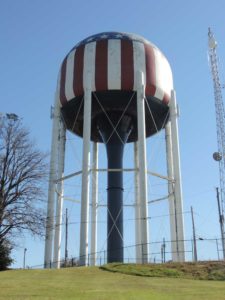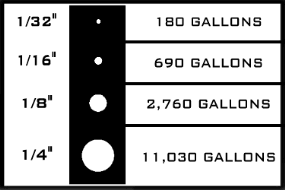Lead Awareness
In 1991, The U.S. Environmental Protection Agency (EPA) established the first Lead and Copper Rule (LCR) to reduce exposure to lead in drinking water. BGMU takes concerns about lead seriously, and we are committed to providing safe drinking water…
Read more about Lead Awareness (PDF)
PFAS Awareness
BGMU’s Water/Wastewater Division
Barren River provides water to residents in Warren County. BGMU pumps river water into the Water Treatment Plant where the water is treated and then pumped to five elevated water storage tanks through more than 290 miles of water mains. The Water Treatment Plant can treat up to 30 million gallons per day. BGMU produces water for both wholesale and retail customers, serving approximately 120,000 people.
BGMU’s Wastewater Plant can treat up to 12 million gallons of wastewater per day. The system is comprised of over 270 miles of sewer mains and serves approximately 20,000 customers. After wastewater is treated, it is returned to the river.
Approximately 75 employees work at both plants. Operators, engineers, chemists, meter technicians, and line crews ensure that safe, reliable drinking water is available to all customers and wastewater is returned to the river cleaner than it was before entering the treatment plant.
For more information on the treatment process, please contact our office at 270-782-1200.

Developer Information
Bowling Green Sewer Ordinance
Industrial Customer Survey
Water Quality Report
Questions & Answers
The customer is responsible for maintaining all water facilities on the customer’s side of the meter. The customer is also responsible for all maintenance of the sewer lateral (including, but not limited to, all grease, root, and debris removal) from the customer’s building to the BGMU main. If failure of the customer’s sewer lateral occurs due to a collapsed pipe under a public street, BGMU will repair said pipe after the collapse has been confirmed.
To find out if a specific home or business is connected to BGMU’s sewer system, please call 270-782-4368. This service is free to anyone who calls.
Even pin-hole sized leaks can cause a significant amount of water loss. At 40 pounds of pressure, you may lose the following amount of water each day:

- Locate your meter, which is typically in your front yard on the corner near the street.
- Remove the protective cover from you meter box. Remember to replace this cover when you are finished.
- Locate the shut-off valve, which is located on the street side of the meter.
- You will need a tee wrench (also called a cut-off key). This wrench can be purchased at any hardware/home improvement store.
- Attach the tee wrench to the shut-off valve and slowly turn the valve clockwise a quarter of a turn.
- Confirm that you have indeed closed the valve and stopped the water flow by going
inside and turning on a faucet. - To reactivate your service, attach the tee wrench to the shut off valve and slowly turn the valve counter clockwise.
- Turn off all faucets inside and outside. Make sure that your dishwasher, washing machine, toilets, etc. are not running.
- Record your meter reading on the water meter located outside your home (usually on a front corner of your property). While recording your reading, you can also check the dial located in the middle of your meter that resembles a pinwheel. If you see that your pinwheel dial is moving, you can assume you have a leak. If the pinwheel dial is not moving, proceed to Step 3.
- Wait 2 to 6 hours using absolutely no water. (Remember not to flush any toilets during this time.)
- Record your meter reading again and compare the two readings.
- If the reading has increased, you may have a leak, and you may want to contact a licensed plumber or repair the leak yourself.
- If the reading is the same, you do not have a leak.
- For more info, check out our video: https://www.youtube.com/watch?v=Nrg7P0NSXYA
Some homes have a type of pressure regulating device that adjusts the amount of water pressure placed on the pipes. When there is a sudden increase in pressure, it is typically because this pressure reducing regulator is in need of repair or replacement. If you are experiencing this type of event, a licensed plumber will be able to assist you in correcting the problem.
The State of Kentucky requires public water systems supply a minimum water pressure of 30 PSI as measured at the customers meter. If you believe your water pressure is less than 30 PSI, some possible causes could be:
- A leak; refer to “How do I check for a leak?”
- The length, size, material and/or age of the service line piping that runs from the water meter to your home or business.
- An older galvanized iron service line that is corroded or clogged.
- Clogged water filters and faucets, home filtration systems, pumping systems, and/or faulty or inappropriately adjusted pressure regulating devices.
A licensed plumber can help you investigate any of these problems that may exist between your water meter and your home or business. If you have investigated these potential causes of pressure loss and would like a technician to check the water pressure at your water meter, please contact our Water/Wastewater Engineering Department at 270-782-4368.
Water can exert a natural force on pipes when it changes directions in fittings an/or bends, or it is suddenly stopped or started. This is commonly called “water hammer.” Sometimes a water outage in your area can cause this, as line repairs can produce air pockets. To see if this is the case, turn on an outside faucet or bathtub faucet and let it run for a few minutes. If the noise continues, here are common causes.
- Commode fill valve is malfunctioning
- Pressure balance valve in tub and/or shower is malfunctioning
- Pressure reducing valve needs to be replaced.
Call a licensed plumber to determine what needs to be done.

